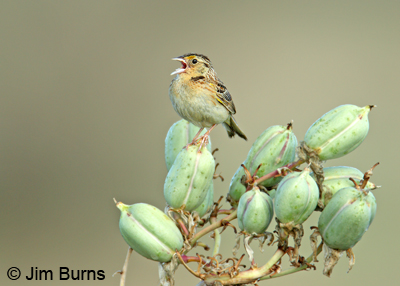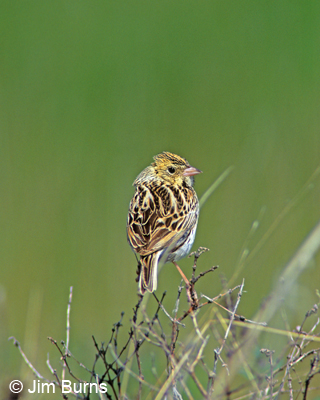
You’re probably not used to seeing “sparrows” followed by an exclamation point. Unless it’s written "those #%&$%@# sparrows!" I have a good friend who serves on the records committee of an eastern state, so you know he’s an experienced and knowledgeable birder. He once said to me, with equal parts disdain and despair in his voice, “I don’t do sparrows.” If that pretty much sums up your feelings about this family of LBJs (little brown jobs), keep reading. There’s an opportunity in Arizona later this month to see well and perhaps even handle some of North America’s most elusive and subtly beautiful bird species.
Janet Ruth, a research ecologist at the University of New Mexico, is looking for volunteers to flush sparrows into mist nets in the grasslands of southeastern Arizona, Thursday through Sunday, January 26, 27, 28, and 29. Dr. Ruth has been studying breeding patterns of Arizona’s resident Grasshopper Sparrow subspecies for the past two summers at the Audubon Appleton-Whitell Research Ranch and the Las Cienegas National Conservation Area. Her goal in late January is to confirm that some of her banded birds are remaining near their breeding territories through the winter.
Volunteers do the easy part, just walking the fields in this wide open and starkly beautiful part of our state spooking sparrows. Janet will be doing the hard part, setting up the nets, removing and banding the birds. There will be opportunities to see the sparrows up close and personal as the banding is done, and perhaps a chance to release them when it is finished. Children are welcome, but she accepts only a limited number of volunteers each day (25-30 and a limit of 8 kids) and takes them on a first come, first served basis.
In case you haven’t figured it out yet, here’s the main attraction for serious birders—Grasshoppers Sparrows aren’t the only LBJs in our southeastern grasslands in winter. In addition to the resident ammolegus Grasshoppers, there are also perpallidus Grasshoppers from the Great Plains, Vesper Sparrows, Savannah Sparrows and the real prize—Baird’s Sparrows. From the distance of the road to the fence wire, even with good binoculars and front lighting, these four species are not easily identified or separable, and most birders would undoubtedly appreciate close, diagnostic looks and Janet Ruth’s wisdom of experience with some of our most difficult and hard-to-see-well sparrows.
Contact Dr. Ruth at janet_ruth@usgs.gov. She will especially need people for the weekday sessions on Thursday and Friday. Improve your identification skills, enjoy a day or two in the scenic splendor of Santa Cruz County, and discover sparrows. If you don't do sparrows, you're missing some checks on your life list but, more importantly, you're missing some of the most intricate and subtle beauty nature and birding have to offer.
